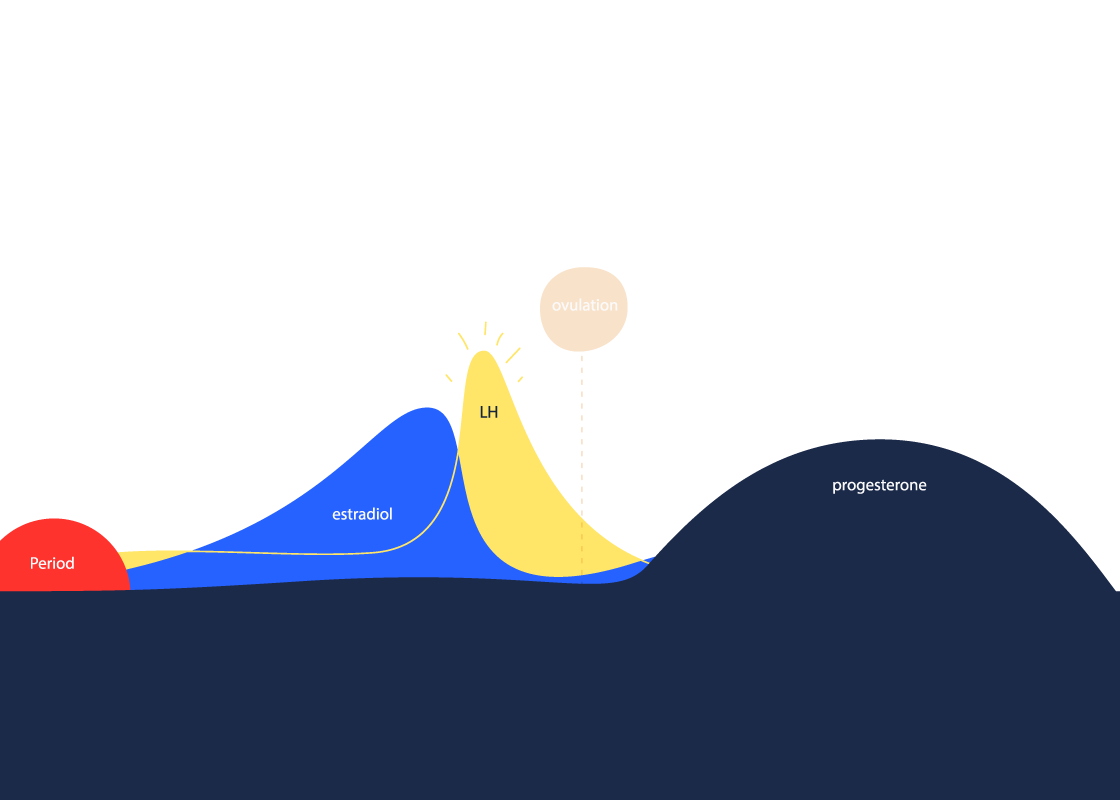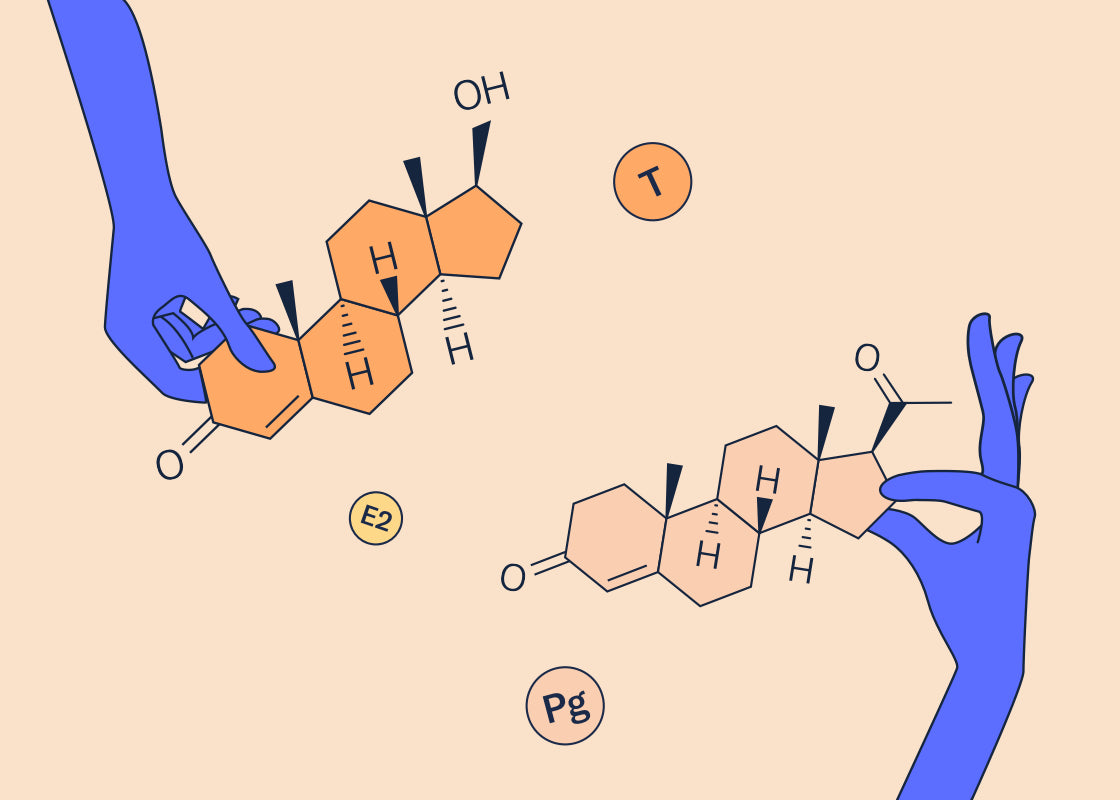If you've been learning how to track your cycle, you may have heard of the luteinizing hormone (LH) surge.
But what is luteinizing hormone to begin with? And how does this hormone affect your body and fertility? Why is there even a need to detect your LH surge?
In this article, we'll explore the function of the luteinizing hormone and the link between the LH surge, ovulation, and fertility. Additionally, we'll look at the function and accuracy of LH tests, and if they help with timing sex for babymaking!
Hormones And Your Menstrual Cycle
Hormones are chemical messengers that regulate various bodily processes. They travel through your bloodstream and affect specific cells or tissues that have receptors designed to receive the message, quite like a lock and key. Once the hormone binds to the receptor at the target site, an action is triggered.
Sex hormones play a vital role in your sexual development, fertility, and menstrual cycle, and the two main sex hormones in females are estrogen and progesterone. Two other hormones essential to regulating your menstrual cycle are the follicle-stimulating hormone (FSH) and the luteinizing hormone (LH).
What Is The Luteinizing Hormone?
The luteinizing hormone is a gonadotropic hormone, meaning that it regulates the function of gonads, which are the ovaries in females. This hormone is produced by the pituitary gland, a small, pea-sized gland sitting at the base of your brain [1].
But what is the function of the luteinizing hormone, and what role does it play in your menstrual cycle?
The most prominent role of this hormone in your menstrual cycle is to initiate ovulation via the LH surge [1].
Alright, so what's ovulation, then?
Well, ovulation refers to the release of a mature egg from the ovary into the fallopian tube. This usually happens in the middle of your cycle.
As the mature egg travels down the fallopian tube, it has a chance of meeting a sperm. If the two meet and fuse, fertilisation occurs. And in about nine months, you'll be carrying a bundle of joy in your arms!
This ovulation process doesn't just randomly occur during your menstrual cycle, and the LH surge is what triggers its occurrence.
But the luteinizing hormone doesn't run the show alone. Backstage, another hormone called the gonadotropin-releasing hormone (GnRH) also ensures things go according to plan.
Your hypothalamus (a gland in your brain) makes and secretes GnRH, and this hormone will stimulate the release of the luteinizing hormone. So technically, your hypothalamus is the person in charge of kickstarting the ovulation process [1]. Meanwhile, the pituitary gland is the puppet that follows its orders, secreting LH accordingly.
What Does A LH Surge Mean?
The LH surge refers to the increase in LH levels during your cycle right before ovulation. This surge initiates ovulation and the release of a mature egg from the ovary into your fallopian tube.
After ovulation, LH levels typically drop back down before the cycle repeats. If you happen to get pregnant, LH levels will continue to remain low throughout your pregnancy.
So, how long after the LH surge will you ovulate?
Well, this varies, but the LH surge usually begins around 35-44 hours before ovulation. LH levels will then peak about 10-12 hours before ovulation [2].
And how long does this LH surge last?
The levels of LH in your blood will steadily increase up to the peak, after which their levels will fall rapidly. The LH surge lasts an average of about 12-24 hours in women, though this varies from woman to woman.
So, in short, the rise in LH levels (LH surge) is an event in your menstrual cycle that occurs near the time of ovulation.
Nonetheless, it is very possible to have an LH surge without any ovulation [2].
What Is A LH Test, And What Does It Do?
The LH test is sometimes also called an ovulation test.
The LH test measures the level of luteinizing hormone in your blood or urine. Since the levels of LH tend to rise just before ovulation occurs, detecting this increase in LH levels allows you to get a rough idea of whether or not you're going to ovulate soon.
One question you may have is this; "When should I have sex after the LH surge?"
Well, here's the thing. Your fertile period lands on the five days before ovulation occurs and the day of ovulation itself. This is the only time in your cycle that you can fall pregnant with sexual intercourse [3].
So, from this, you'll notice that the LH surge occurs during this golden window of opportunity since the LH surge happens right before ovulation. In other words, you shouldn't have to wait until after the LH surge has passed to have sex to get pregnant.
How To Use LH Tests
LH tests commonly come as a urine test that you can do at home. You'll either urinate on the stick or into a cup and place the stick into it.
These tests usually come with two lines. If you notice that the "test line" is as dark or darker than the "control line," you're likely about to ovulate soon.
You can choose to have sex on the day of this positive result or up to 2 days after to maximise your chances of falling pregnant [2].
You can also have the levels of LH detected through blood tests. However, this is not as feasible in terms of cost and convenience.
Are LH Tests Accurate?
Well, these tests are thought to be accurate if used correctly—that is, they are accurate at detecting your LH levels.
Some research studies have concluded that detecting urinary LH surges using at-home test kits may be an inexpensive, accurate, and non-invasive method of predicting ovulation. Related research shows that the average time interval between a positive LH test result and follicular rupture during ovulation is around 20 hours [2].
Healthy sperm can survive up to 5 days inside the female body after ejaculation [2]. Since the LH surge occurs just before ovulation, having sex on the day of a positive LH test result or up to 2 days after may increase your odds of conceiving [2].
Here's a theoretical scenario of how the LH test may help. You get a positive result due to a surge in LH levels, and you have sex on the same day. Your partner's sperm hangs around while waiting for the egg to be released.
Because the LH positive result usually predicts ovulation within 48 hours, the healthy sperm do survive until the grand day of ovulation arrives [2]. Once the mature egg is released during ovulation, a surviving sperm penetrates and fuses with it, fertilising it.
This is how an LH test will work—theoretically. But in real life, things don't always align with textbook guidelines.
These tests can indeed detect LH levels in your blood pretty accurately. However, LH tests will not be able to detect ovulation or confirm that it has taken place. You will also be missing the first few days of your fertile window if you rely solely on the LH test.
Limitations of LH Tests
Firstly, every woman's cycle and body are unique. And hence, not every woman's cycle fits cookie-cutter standards.
Essentially, your LH test results may not always be an accurate predictor or indicator of ovulation. This is because the LH surge can present very differently from one woman to another.
For instance, you may not even experience an LH surge at all. Other than that, the LH surge may occur very rapidly in some women (about one day) and much slower in other women (about 2-6 days) [4].
Furthermore, the rise in LH levels can also be very high for some women and much lower and less prominent for you, or vice versa [4]. In some cases, LH levels may even remain too low to be detected by certain test kits.
That's not all. These are some other limitations of LH tests:
- The manufacturer's instructions are commonly based on 'textbook standards,' so these instructions typically state that testing should begin only after day 10 or 11 of the cycle. This may not be optimal for some women with different cycle lengths. In fact, less than 16% of women have a standard 28-day cycle [5].
- The LH peak could occur after ovulation in some women. If you start testing too late in your cycle, the positive result could signal a peak (which may or may not have occurred after ovulation). Starting ovulation tests earlier on in your cycle may help counter this—since the LH surge may be a better predictor that ovulation is about to occur compared to the LH peak [6].
- It can be difficult to interpret your results since it's hard to tell if the line is dark enough to count as a positive result.
- LH tests cannot detect ovulation or confirm that it has taken place. Some women may even experience an LH surge without any ovulation [2]. Tracking your cycle with another hormone, like progesterone, on top of your LH tests will help confirm that ovulation has occurred.
All these factors can affect whether you'll get a clear positive result and whether that positive result truly signifies that ovulation is about to occur. False positives can lead to a lot of frustration, but this can be overcome by using more than one method of cycle tracking.
Tracking Your Cycle With Progesterone
Here's the thing. The positive result you get from the LH test does not accurately pinpoint your exact ovulation date.
Let's say you choose to have sex only on the day of the positive result. The thing is, ovulation could happen anytime between 24 and 48 hours after the positive result.
Lower-quality sperm may not survive until ovulation occurs. Or perhaps, they may not travel fast enough to reach the mature egg before it dies—the released egg usually only survives a few hours after ovulation, while lower-quality sperm may take more than 2 days to travel to the ovum [7]. In these cases, you miss the chance for fertilisation and pregnancy to happen during that cycle.
Progesterone levels will change throughout your cycle as well. Hence, keeping track of your progesterone levels can also give you an idea of when ovulation is likely to occur. When done alongside LH tests, tracking your progesterone curve can help you better determine when your fertile period and day of ovulation land in each cycle.
The inne minilab helps you do just this. It measures your progesterone levels through simple, non-invasive saliva tests, which you can perform daily to track your cycle.
Your results will be automatically interpreted and delivered through the inne smartphone app. Through the app, you can easily see your unique cycle, pinpoint your personalised fertile period, and confirm your ovulation day.
With all this information, you'll then know the best time for fun in the sheets to boost your odds of pregnancy. We promise you—there's no easier or simpler way than this to learn about your unique cycle and find out when you're fertile!
References
1. Nedresky D, Singh G. Physiology, Luteinizing Hormone. In: StatPearls. Treasure Island (FL): StatPearls Publishing; September 28, 2021.
2. Su HW, Yi YC, Wei TY, Chang TC, Cheng CM. Detection of ovulation, a review of currently available methods. Bioeng Transl Med. 2017;2(3):238-246. Published 2017 May 16. doi:10.1002/btm2.10058
3. Wilcox AJ, Dunson D, Baird DD. The timing of the "fertile window" in the menstrual cycle: day specific estimates from a prospective study. BMJ. 2000;321(7271):1259-1262. doi:10.1136/bmj.321.7271.1259
4. Park SJ, Goldsmith LT, Skurnick JH, Wojtczuk A, Weiss G. Characteristics of the urinary luteinizing hormone surge in young ovulatory women. Fertil Steril. 2007;88(3):684-690. doi:10.1016/j.fertnstert.2007.01.045
5. Grieger JA, Norman RJ. Menstrual Cycle Length and Patterns in a Global Cohort of Women Using a Mobile Phone App: Retrospective Cohort Study. J Med Internet Res. 2020;22(6):e17109. Published 2020 Jun 24. doi:10.2196/17109
6. Leiva RA, Bouchard TP, Abdullah SH, Ecochard R. Urinary Luteinizing Hormone Tests: Which Concentration Threshold Best Predicts Ovulation? [published correction appears in Front Public Health. 2018 Nov 30;6:345]. Front Public Health. 2017;5:320. Published 2017 Nov 28. doi:10.3389/fpubh.2017.00320
7. Pizzorno JE, Murray MT, Joiner-Bey H, Chapter 42-Infertility, female. In: The Clinician's Handbook of Natural Medicine. 3rd ed. 2016;485-520. doi: /10.1016/B978-0-7020-5514-0.00051-8.




